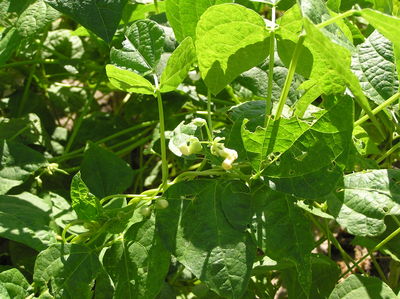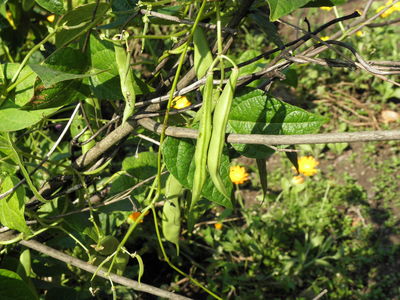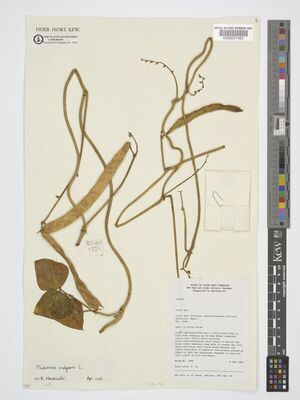Geography and distribution
The common bean originated in Central and South America where small seeded wild types can still be found growing today. Domestication occurred in Central America (Mexico and Guatemala) and in South America (Peru) independently leading to two distinct genepools.
The common bean is an ancient crop and archaeological evidence indicates that it was being cultivated as early as 6,000 BC. The crop was brought to Africa in the 16th century by Portuguese traders and carried to high altitude regions by slave trading caravans and merchants.
Today, common bean is a globally important crop, especially in North and South America, Europe and Africa. They are less common in India, where other pulses are preferred.
Description
Overview: Phaseolus vulgaris is an annual herb up to 3 metres long which can be found growing in climbing, trailing, or erect and bushy forms. It has a well developed taproot with many lateral roots.
Leaves: The leaves are arranged alternately along the stem; each leaf supported by a petiole (appendage which connects the leaf to the stem) which is grooved above and thickened at the base and can be up to 30 cm long. Each leaf is composed of 3 ovate (2 dimensional egg-shaped) leaflets, up to 20 cm x 15 cm in size.
Flowers: The flowers are arranged alone or in pairs along an unbranched axis (a raceme). The flowers are white, pale purple or red-purple and are papilionaceous, resembling those of the pea, Pisum sativum . Each flower has 10 stamens (male reproductive organs), nine of which are fused into a partial tube, with the tenth stamen free. The ovary (female reproductive organ) is positioned above the sepals, petals and stamens. The style is upturned and spiralled, with a collar of fine hairs below the stigma.
Fruits: The fruit is a linear pod up to 20 cm long which is fleshy when immature and can be green, yellow, red or purple and contains up to 12 seeds. The seeds are up to 2 cm long and can be rounded, kidney-shaped, ellipsoid or oblong. They vary in colour from black, brown and yellow types to red, white, speckled and flecked forms.
Uses
Common bean is an important food crop adding flavour, protein and essential vitamins and minerals (such as iron and folic acid) to the diets of millions of people throughout the world. The dry mature seed are mostly eaten as a pulse and the immature pods and seeds as a vegetable. Common bean is often considered the 'meat of the poor' and forms the main protein source for people in many countries although it is also popular with wealthier consumers.
In tropical Africa the seeds are typically boiled with seasoning and oil. They can also be eaten mashed or made into soup. The seeds of the common bean are canned in many parts of the world, either alone or in tomato sauce. When food is scarce some people consume the leaves as a vegetable, but the majority of cultivars have leaves which are too tough to be eaten. In Java, the young leaves of the plant are eaten as a salad.
In temperate regions it is more common to grow Phaseolus vulgaris for its green immature pods (French bean) which are canned, frozen or eaten fresh.
As well as being an excellent food source for humans, the crop can be used as fodder to feed animals.
Common bean plays an important role in folk medicine and is said to relieve a variety of ailments from acne and diabetes to diarrhoea, eczema and even hiccups.
Some unusual uses for Phaseolus vulgaris include using the leaves to trap bedbugs in houses (the insects get caught on the leaf's microscopic hairs (trichomes), and using the beans to tell fortunes, a method of divination known as favomancy.
Crop wild relatives of common bean
The Millennium Seed Bank and the Global Crop Diversity Trust are engaged in a ten-year project, called 'Adapting Agriculture to Climate Change'. The project aims to protect, collect and prepare the wild relatives of 29 key food crops, including common bean, so that they are available to pre-breeders for the development of new varieties that are more resilient to the effects of climate change.
Millennium Seed Bank: Seed storage
The Millennium Seed Bank Partnership aims to save plants worldwide, focusing on those plants which are under threat and those which are of most use in the future. Once seeds have been collected they are dried, packaged and stored at -20°C in our seed bank vault.
Description of seeds: Average 1,000 seed weight = 319 g
Number of seed collections stored in the Millennium Seed Bank: One
Seed storage behaviour: Orthodox (the seeds of this plant can be dried to low moisture contents without significantly reducing their viability. This means they are suitable for long-term frozen storage such as at the MSB)
Germination testing: Successful
This species at Kew
Pressed and dried specimens of common bean are held in Kew's Herbarium, where they are available to researchers by appointment. Details and images of some of these specimens can be seen online in Kew's Herbarium Catalogue.













